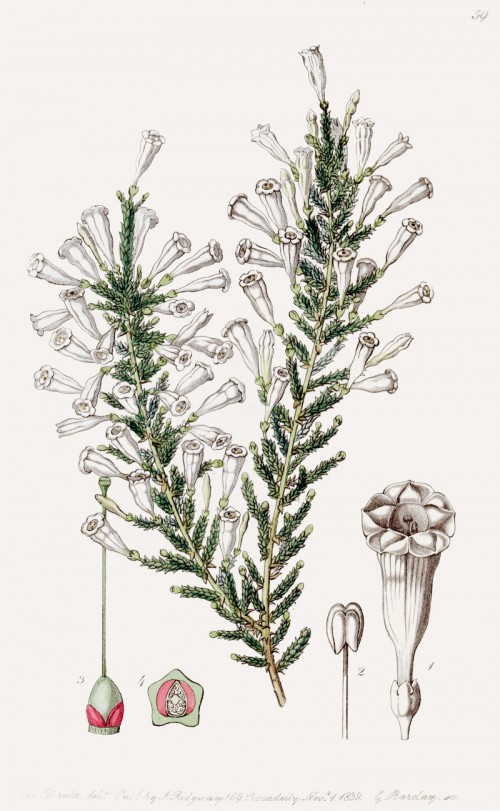Benutzer-Werkzeuge
Fabiana imbricata Ruiz & Pav. - Solanaceae - pichi-pichi, Pichi
Evergreen shrub, up to 2m tall, native to Chile (Peru, Argentina); leaves tiny, scale-like, ovate; flowers white, tubular. Also cultivated as ornamental with pale violet flowers (F. imbricata f. violacea).
https://www.rhs.org.uk/plants/details?plantid=4346
The aerial parts of F.imbricata contain variyng amounts of rutin (195-1,950 mg%) and scopoletin (240-2,400 mg%).
[ Rutin and Scopoletin Content and Micropropagation of Fabiana imbricata Razmilic, I., Schmeda-Hirschmann, G., Dutra-Behrens, M., Reyes, S., Lopez I., Theoduloz,C., Planta medica, Vol.60(02), 1994, 140-142]
„An infusion or decoction of the aerial parts of Fabiana imbricata (Solanaceae) is used in traditional medicine in Chile and Argentina as a digestive and diuretic agent. The main sesquiterpene of the plant was identified as 11-hydroxy-4-amorphen-15-oic acid. At doses of 25, 50 and 100 mg/kg, the compound showed a dose-dependent gastroprotective effect in HCl/EtOH-induced gastric lesions in mice reducing the lesions by 68% at 100 mg/kg.“
[Gastroprotective activity of sesquiterpene derivatives from Fabiana imbricata. Reyes, M., Schmeda‐Hirschmann, G., Razmilic, I., Theoduloz, C., Yáñez, T., Rodríguez, J. A., Phytotherapy Research, Vol.19(12), 2005, 1038-1042]
„“Pichi” or “pichi romero” (Fabiana imbricata R. et. P., Solanaceae) is a Chilean plant used as a tea in the Andean regions of Chile and Argentina. A very simple and direct method was developed for the qualitative analysis of polyphenols in the tea by high-performance liquid chromatography (HPLC) with diode array detection and electrospray ionization tandem mass spectrometry. The phenolic constituents identified in the teas were chlorogenic acid (3-O-caffeoylquinic acid), p-hydroxyacetophenone, scopoletin and quercetin derivatives. The glycosides were mainly glucosides from p-hydroxyacetophenone and scopoletin while di- and tri-glycosides from quercetin were the main flavonoids. The content of the main phenolic compounds in the teas (g/100 g lyophilized infusion) was 0.8–1.9 % for scopoletin, 0.4–6.2 % for p-hydroxyacetophenone and 2.1–4.3 % for rutin, respectively. The health-promoting properties reported for this herbal tea can be associated with the presence of several phenolics with known antioxidant, diuretic and antiinflammatory activity.“
[Phenolic constituents of the Chilean herbal tea Fabiana imbricata R. et P., Quispe, C., Viveros-Valdez, E., Schmeda-Hirschmann, G., Plant foods for human nutrition, Vol.67(3), 2012, 242-246]

Edwards’s Botanical Register, vol.25 t.59 (1839) [S.A.Drake]
http://plantgenera.org/species.php?id_species=429283
